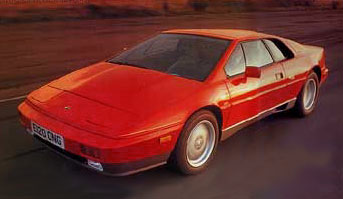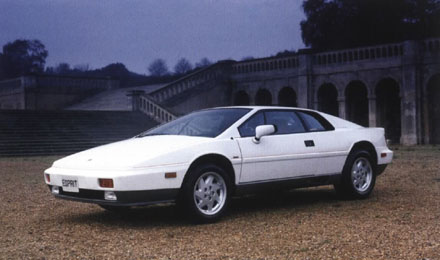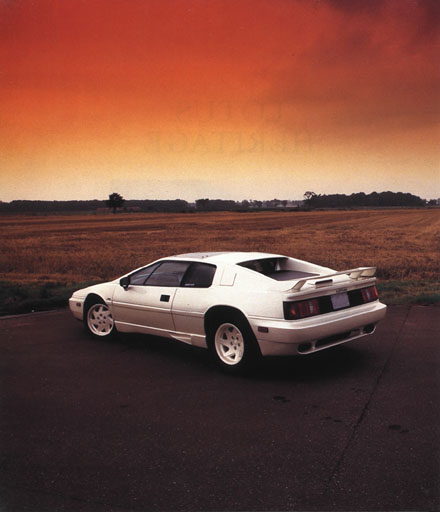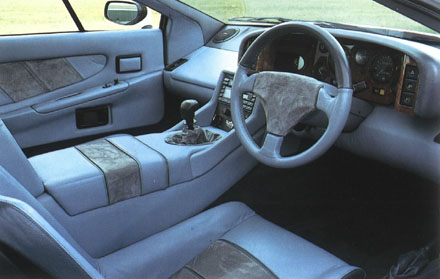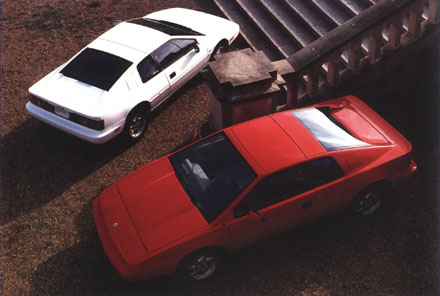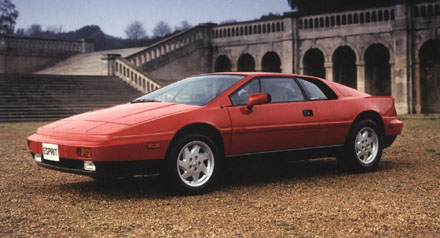
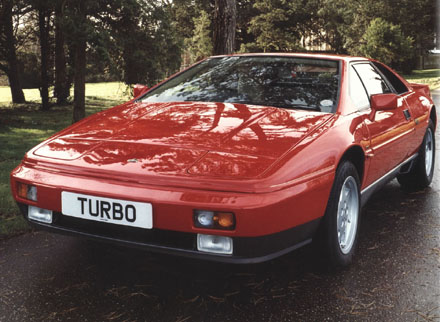
Lotus Esprit Turbo
Buyers Guide
The Lotus Esprit appears to have been with us for a long time, fighting Italian mid-engined exotica for supercar supremacy from its base in darkest Norfolk. Catch sight of an Esprit on the roads today and the arresting silhouette still has enough drama and poise to warrant a double-take. Impossibly low, fabulously sleek, beautifully proportioned and clean, it looks like a low-flying missile locked on to its target. Like the Porsche, the Lotus has been the subject of constant development, but for us it was the Peter Stevens redesign of 1987 that marked the Esprit's ascendancy to true superstardom.
Stevens softened the edges of the sharply creased, wedgy Giugiaro original, endowing it with a butch, muscular body, it's these cars, fitted with 4-cylinder turbo powerplants, that now make the best buys second-hand and therefore it's these that we will be focusing on here.
Of course, for people like us the looks would count for nothing if they weren't matched by equally stunning driving dynamics and stirring performance. The Lotus reputation has been built on fiercely precise, incisive handling with feelful steering combined with a compliant, supple ride, and the Esprit certainly did its bit to enhance that reputation. It doesn't have the nervous handling traits that have plagued many mid-engined cars; instead it has an abundance of grip with incredibly sharp turn-in and power oversteer that's so controllable you just can't help indulging yourself. In this respect the Esprit is brilliant, confidence-inspiring and intoxicating, urging you to drive it hard. But it does have flaws. The turbos suffer from lag, the engine note has uncharitably been likened to a cement mixer full of rocks, the gearchange lacks precision and some aspects of the interior have remained firmly in the '70s. The pedals are offset and cramped; the trim rattles and creaks; the style is definitely old-school. Whether you can live with that depends on where your priorities lie.
Lotus Esprit 40th Anniversary (Federal Spec)
Lotus Esprit 40th Anniversary Interior
If you can accept the shortcomings, the Esprit represents fantastic value for money. An early Lotus Esprit Turbo in perfect condition can cost just £10,000 and from a specialist dealer too. Rarely does so little money by quite so much automotive theatre. But buying the car is one thing; running it can be quite another. Lotuses have in the past developed another, less desirable reputation, one for poor reliability and big, big bills. You needn't be scared - you just need to know what you're looking at and the possible pitfalls. Treat it right and the Esprit can be reliable enough to be used as daily transport. In fact it works better that way. Like a lot of other high performance machinery, the Esprit responds better to regular use than occasional outings - and ultimately it will prove more economical per mile too. As we will see, some of the servicing will require deep exploration of your wallet. The simple fact is that although you may be able to buy an Esprit Turbo for hot hatch money, this is no mass-produced tin-top and parts are expensive. You can't shortcut the expense either. Fitting substandard parts and delaying services will, in the long-term, prove false economy, with expenditure spiralling higher to cover even bigger problems further down the line. Buy the best you can afford, but don't ignore the running costs.
Evolution
Not only did the car change in 1987, but the name did too. Up until that time, it was always known as the Turbo Esprit, but the two words were reversed to mark the Peter Stevens redesign. Underneath, it was essentially the same car. Boost was increased to add 5bhp to the 210 of the Giugiaro version, giving the Esprit Turbo a top speed of 146mph. More importantly, the pensionable Citroen SM gearbox was junked in favour of a Renault 25 unit, which, although criticised today, seemed a big leap forward at the time. There was a short-run special edition in '89, the 40th Anniversary model, which was the last carburettor-equipped Esprit, and that made way for what was to become the biggest selling variant, the Turbo SE. Its emissions-friendly fuel injection system combined with a chargecooler (a water-to-air intercooler) helped the 2.2-litre twin-cam 16-valve four to produce 264bhp, pushing the Esprit on to 164mph. Aside from the badges, the SE could be identified by a fairly subtle rear wing, an oil-cooling duct ahead of the front wheels, straight-line side-skirts and larger, fatter wheels. Suspension geometry was slightly revised to cope with these changes, but little adjustment was needed - the chassis was already the Esprit's strength.
Checkpoints
Having decided to take the plunge into Esprit ownership, you need to decide which model to go for. With so many different versions, numbers of each specification are low, so finding the ideal car may take some time. Try to drive as many as you can and use every available resource to swat up on your chosen subject. It's time well spent, because the rewards can be very satisfying indeed. A full history is absolutely vital, and ideally the car should come with a thick wad of bills and receipts too. It's the only way to tell just how meticulously the car has been maintained and how fresh the main components are. Buying an Esprit without this information is a complete folly - chances are you'll face a constant stream of bills to keep the car on the road. The service history should carry the stamps of either a main Lotus dealer or a recognised independent specialist - your best guarantee that any work has been done correctly and with proper parts. These specialists will also have the correct equipment for checking the management system, which although expensive is the only means of doing the job properly. Every year saw improvements in terms of strength and longevity of parts, so early SEs will require more TLC than an S4. And a car that's had numerous owners should always raise doubts. Bad cars cost a lot just to keep running, and restoring a rough one can prove a financial nightmare.
Engine
The engines themselves, as long as they are serviced regularly, are reliable and strong, but there are some points to note. the first thing to check here is that the cam belt has been replaced at the correct intervals, because these intervals are very short. Originally they were set at 24,000 miles, though they were extended by the factory in the mid- '90s to 32,000. Most specialists, however, recommend that you stick to the original schedule. Not having it done could prove an expensive mistake. Owners should always allow the engine plenty of time to warm through. Remember that these are low-capacity, high-output engines and revving them from cold will seriously reduce their potential lifespan. If cared for, they can see the far side of 100,000 miles before needing a rebuild. Specialist dealer Paul Matty says that he has seen Esprits with 150,000 on the odometer, although he admits they were breathing quite heavily by that stage. If the temperature starts to rise, stop and let the engine cool before continuing your journey. Fan failure is a common problem and, although it's easy to fix, overheating will ruin the head gaskets and cause the liners to sink. There is no excuse for allowing this to happen though, as the facia has both a temperature gauge and fan failure warning light. The chargecooler vanes have been known to disintegrate, but there is no impact on other components and the replacement cost is less than £100. Another SE problem regularly seen in Lotus service bays is leaks from the water pumps used by the chargecoolers. Again a fairly straightforward fault to put right, but it pays to catch it early. The Turbos last well and if they do fail an exchange unit can be fitted for less than £300. If you smell petrol in the cabin then it's likely that all that's needed are replacement hoses. The engine mounts should be examined and replaced promptly if in poor condition - the ones on the left side suffer most, and failure to replace them can damage other items such as hoses and even the exhaust.
Transmission
Although the Renault gearbox isn't the most satisfying to use, it is strong and well up to the job in hand. Ensure that it doesn't feel stiff, though, as a lack of lubrication will cause the shaft to rust up, requiring the silencer to be dropped before it can be accessed. Clutch replacement is an even more time-consuming task as the gearbox needs to come out, taking around 11 hours. The clutch should be replaced at the first sign of it slipping to prevent further (more costly) damage to the flywheel.
Suspension
Very strong and can easily run for 100,000 miles before the shocks need renewing. Occasionally, small fracture-cracks on the front springs develop - something that should be picked up during service.
Steering, wheels and tyres
The combination of large front wheels and a small rack means the the rack is put under a lot of stress, resulting in wear. It therefore has to be replaced every other year, but this can be done economically with the installation of exchange unit. Excessive play in the steering is a sure sign that it's on the way out, so test for this on the test drive.
Exhaust
Examine the exhaust and wastegate manifolds for cracks, which can be caused by the constant expansion and contraction from the extreme temperatures they reach during extended periods of hard running. The studs can also get stuck in the manifold and these are very expensive and complicated jobs to put right.
Brakes
The brakes last well, considering the performance, and should feel strong. As always, wear rates will vary considerably, but because the car is relatively light it will resist wear and fade well enough to survive a track-day outing. Ensure the handbrake ratchet operates correctly; the fix is expensive
Bodywork/Interior
The electrical systems, although complicated, rarely fail, but don't forget to check that everything works - if there's a problem it may be awkward to rectify. Non-functioning electric windows are often down to failing switch rather than the motor, so always swap that (cheap) part first. The headlight pods occasionally fail - when they do the culprit is usually a short circuit caused by water ingress, which will need to be dried out. The paintwork on some of the older cars can show signs of cracking as the glassfibre ages, and red paint can start to date to a pinkish hue. There is only one way to solve both of these faults and that's a cash-intensive respray. Underneath those panels there should be no problems as the chassis is fully galvanised. If the car is not used for a long period, the air conditioning system breaks up and needs to be replaced, which will be very expensive. The simple solution is to run the car for a while every other week or so.
